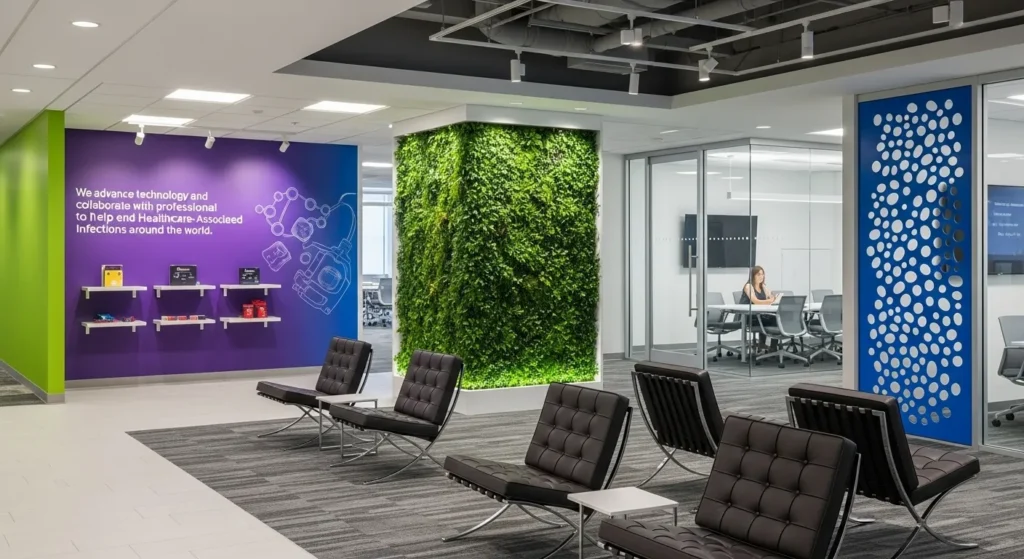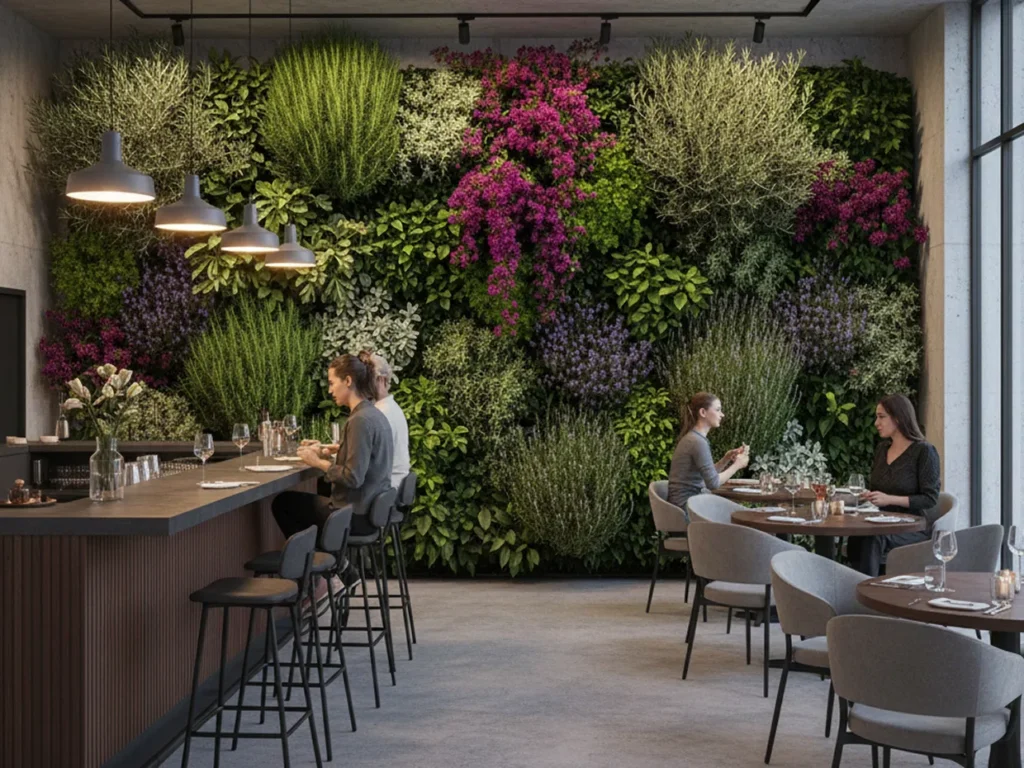

What Are living green walls and Artificial Green Walls?
Living green walls are a symbol of sustainable design — living ecosystems built into architectural surfaces. They consist of soil or hydroponic systems supporting live plants that grow vertically on structures or panels. These walls improve indoor air quality, provide natural insulation, and create a stunning connection between humans and nature — an essential principle of biophilic design.
However, maintaining a living wall requires irrigation, lighting, and ongoing plant care. In corporate environments, where aesthetics must remain consistent year-round, maintaining a lush green appearance becomes challenging. That’s where artificial living walls or a faux living wall can become the practical and aesthetic solution architects turn to.
Why are artificial living walls transforming interior design?
Artificial greenery — often referred to as fake living wall, faux living wall, or living wall artificial — mimics the beauty of live foliage without the operational complexity. High-quality replica greenery can appear indistinguishable from real plants while offering architects total creative control.
An artificial living wall allows design freedom in areas without sunlight or access to water, like underground offices, atriums, or feature corridors. It’s durable, maintenance-free, and completely customizable in texture and density. Moreover, architects can integrate sound-absorbing materials behind fake live wall installations, turning them into dual-purpose acoustic and visual features.
How do living and faux live walls compare in performance and maintenance?
| Feature | Living Green Wall | Artificial Green Wall |
|---|---|---|
| Material | Natural plants and soil/hydroponic systems | Synthetic foliage (often PE or ThermaLeaf® technology) |
| Maintenance | High – watering, pruning, pest control | Low – no irrigation, pruning, or sunlight required |
| Longevity | Plant life cycles may vary | 10+ years lifespan with minimal upkeep |
| Installation | Complex – requires irrigation and drainage | Simple – modular panels, ready-to-install |
| Sustainability | Natural carbon capture | Uses recyclable and fire-rated materials |
| Ideal Use | Environments with natural light and irrigation infrastructure | Areas with limited light or maintenance staff |
Artificial systems have evolved far beyond their early “plastic” reputation. Modern living wall fake systems are built with realistic leaf textures and botanical accuracy that complement contemporary interiors while keeping visual warmth intact.
Can artificial greenery deliver the same psychological benefits as real plants?
Yes — even exposure to living wall artificial installations can trigger the same biophilic responses as real plants. Replica greenery stimulates feelings of calm and productivity while maintaining consistent beauty over time.
Architects and designers can strategically use faux live wall panels in wellness-oriented environments such as healthcare centers, co-working spaces, and retail interiors to create nature-inspired comfort zones without maintenance constraints.
Where do acoustic and decorative design meet in artificial walls?
Artificial greenery can serve more than an aesthetic role — it can enhance acoustics when integrated with sound-absorbing backers. By pairing a fake live wall or artificial living wall with acoustic felt or PET panels, designers can achieve superior sound absorption while maintaining a natural visual texture.
This integration is crucial for open offices, lobbies, or hospitality spaces where acoustic comfort defines the user experience.

AgeaMed, Artificial Green Wall Design by CSI Creative
Why is customization essential when choosing between real and fake living walls?
Every space communicates a brand. Architects need flexibility in color, density, and modularity. With artificial options, you can design faux living wall systems tailored to your project’s geometry, color palette, and maintenance profile. Living systems, while beautiful, are limited by environmental constraints such as light, temperature, and irrigation.
For projects seeking a balance between natural aesthetics and performance, living wall artificial systems become the ideal blend of form and function.
design options, realism, irrigation, and system types that May influence your green wall choice
Design Options & Realism
Today’s artificial living walls offer exceptional realism through layered textures, botanical accuracy, and authentic coloration. High-end faux living wall systems use UV-stable, flame-retardant materials that replicate everything from tropical foliage to dense boxwood. Designers can select among:
- Trimmed varieties for clean geometric installations in offices and schools.
- Lush varieties for organic, free-flowing compositions in restaurants or lobbies.
- Mixed configurations blending species and densities for visual rhythm and brand personality.
Meanwhile, living green walls can feature real moss, ferns, or flowering plants — each selected for its tolerance to the interior microclimate. Yet their vitality depends on light, temperature, and watering cycles, making realism unpredictable over time.
Irrigation and Environmental Control
A key distinction lies in irrigation. Living systems need hydroponic or drip irrigation, drainage trays, and often integrated grow lights — all increasing the wall’s depth and structural load. Artificial systems, such as a living wall fake, eliminate all irrigation, offering predictable form and longevity. This makes them ideal for sealed interior spaces or high-ceiling environments without access to plumbing.
Modular vs. Non-Modular Systems
Modular panels (typically 2×2 ft or 4×4 ft) simplify design coordination, maintenance, and scalability. They allow rapid replacement, predictable density, and clean grid alignment. Non-modular systems, often custom-fabricated, are seamless and continuous — best for feature walls where visual flow outweighs ease of maintenance.
For live systems, modularity helps isolate irrigation zones; for faux systems, it supports installation flexibility and replacement without disturbing the wall’s entire surface.
Attachment Methods
Attachment design affects both visual precision and long-term stability.
| System Type | Typical Attachment | Best Use | Design Advantage |
|---|---|---|---|
| Living (Modular) | Metal grid or track with irrigation manifold | Atriums, vertical gardens | Enables water flow and drainage |
| Living (Non-Modular) | Custom structural frame | Large façades | Seamless organic coverage |
| Artificial (Modular) | Z-clips or direct screw-mount | Offices, hotels | Quick installation, adjustable layout |
| Artificial (Non-Modular) | Hidden clips or magnetic mounts | Feature or brand walls | Invisible seams, clean finish |
Architects value attachment systems not only for their install efficiency but for adaptability — fake live wall panels can be reconfigured during renovations, whereas live systems are often permanently integrated into irrigation infrastructure.
What is The CSI Creative Offering in Green Wall Solutions?
CSI Creative bridges biophilia and acoustic science through its Acoustic Greenery Systems, available as both replica (artificial) and live installations. The CSI Creative’s artificial living walls use ThermaLeaf® fire-retardant technology, making them compliant with major fire codes worldwide while remaining lush and hyper-realistic.
Key advantages of CSI’s Green Wall Systems:
- ASTM E84 Class A Fire Rating
- No water, light, or pruning required
- High NRC (Noise Reduction Coefficient) performance
- Fully customizable density (Trimmed, Lush, or Mixed)
- Easy installation with pre-assembled panels
With CSI Creative, architects gain design freedom — crafting immersive environments where greenery meets precision acoustics. Our award-winning designs (Architizer A+Product Awards 2024 and 2025) and WELL-certified materials position CSI Creative as the go-to partner for sustainable, aesthetic, and high-performance architectural systems.
In essence: Whether your project calls for a living or fake living wall, CSI Creative’s Acoustic Greenery Collection offers the flexibility to achieve biophilic design without compromise. From living wall artificial systems that stay evergreen to hybrid acoustic installations, CSI empowers designers to create spaces that inspire, perform, and endure. Ready to start your project? Contact us today.







